41 Species of Ducks Found in Texas (ID &Calls)

Welcome to our article on the amazing variety of 41 duck species in Texas! investigate the rich diversity of ducks, from dabblers to divers, that make Texas a birdwatcher’s haven.
Discover their unique behaviors and the special habitats they call home.
List of 41 Species of Ducks Found in Texas:
1. Northern Pintail (Anas acuta):

The elegant Northern Pintail is easily recognizable by its long, pointed tail feathers and slender profile. The male boasts a striking combination of white, chocolate-brown, and iridescent green plumage, while the female’s mottled brown camouflages her during nesting. Their soft whistles and subtle quacks make them a joy to listen to during their migration seasons.
Pintails feed in shallow waters, often dabbling for plants and insects. They nest near wetlands and lay 6-12 eggs. In Texas, you can find them in coastal marshes and prairie ponds.
- Length: 20 – 26 in (51 – 66 cm)
- Weight: 36.33 oz (1030 g)
- Wingspan: 29 – 35 in (74 – 89 cm)
Call:-
Male
Female
2. Eurasian Teal (Anas crecca):
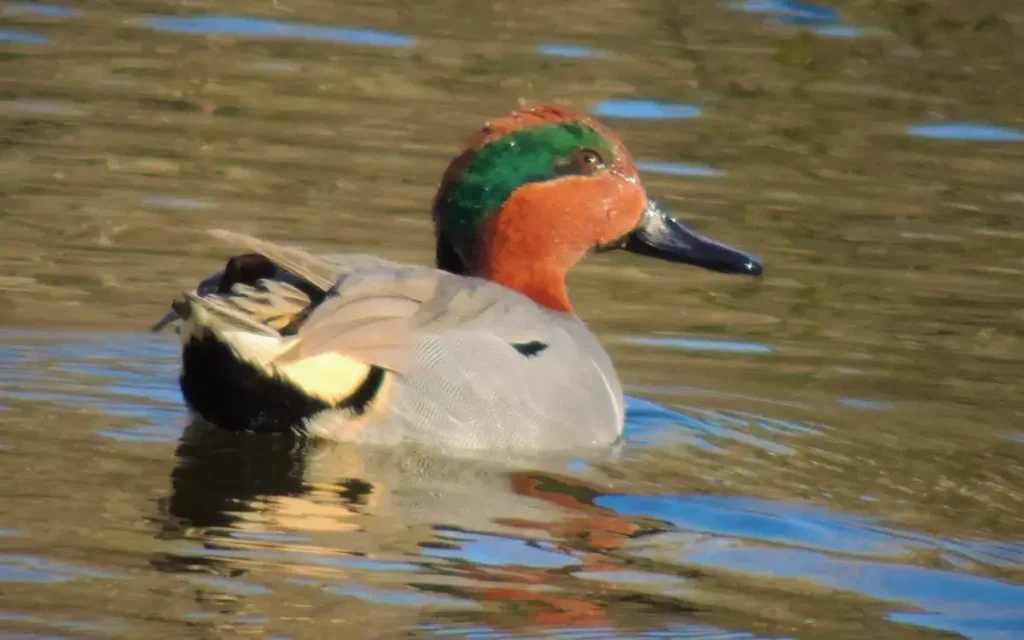
This small but vibrant duck, also known as the Green-winged Teal, features a distinct green wing patch on the male and intricate brown patterns on the female.
Their high-pitched whistling calls are music to the ears of birders lucky enough to spot them during the winter months.
These small dabbling ducks are found in a variety of wetland habitats. They lay 5–16 eggs in grass-lined nests. While they mainly inhabit Europe and Asia, rare sightings might occur in Texas.
- Length: 34–43 cm (13–17 in)
- Weight: 11 – 13 oz (312 – 369 gm)
- Wingspan: 20.87 – 23.23 in (53–59 cm)
3. Wood Duck (Aix sponsa):

The Wood Duck’s stunning multicolored plumage and crested head make it a favorite among birdwatchers.
These cavity-nesting ducks emit a series of sharp whistles and gentle calls. Spring is the best time to spot them, as they navigate their way through forested wetlands.
Wood ducks nest in tree cavities, sometimes far from water. They lay around 7-15 eggs. Look for them in wooded swamps, ponds, and lakes throughout Texas.
- Length: 18.5 – 21.3 in (47 – 54 cm)
- Weight: 16.0 – 30.4 oz (454 – 862 gm)
- Wingspan: 26.0 – 28.7 in (66 – 73 cm)
Wood Duck call:-
Male
Female
4. Mottled Duck (Anas fulvigula):

As a year-round resident of Texas, the Mottled Duck is a familiar sight in marshes and coastal habitats. The male’s mottled brown and buff-colored appearance adds to its unassuming charm. Their soft quacks and occasional grunts create a serene ambiance in their habitat.
Preferring coastal marshes and estuaries, mottled ducks feed on aquatic plants and insects. They lay 8-12 eggs in grassy nests. Common in Texas along the Gulf Coast.
- Length: 21 inches
- Weight: 2 1/4 pounds
- Wingspan: 95.7-106.3 in (243-270 cm)
5. American Wigeon (Anas americana):

Distinctive for their white foreheads and striking color patterns, American Wigeons can often be found dabbling in shallow waters. Their whistling calls resonate through wetlands during migration, adding a touch of wilderness music to the air.
Wigeons feed on aquatic plants and invertebrates. They nest in grassy areas, laying 6-11 eggs. These ducks can be seen in Texas during migration and winter in various wetland habitats.
- Length: 16.5 – 23.2 in (42 – 59 cm)
- Weight: 19.1 – 46.9 oz (540 – 1330 g)
- Wingspan: 33.1 in (84 cm)
Call:-
Male
Female
6. Mallard (Anas platyrhynchos):

Arguably the most recognizable duck species, the Mallard’s iridescent green head and distinctive quack are iconic. These adaptable birds are found across Texas year-round, and their varied vocalizations range from the classic quack to softer, more intimate calls.
Mallards are adaptable dabbling ducks. They lay about 8-12 eggs in nests near water. Mallards can be found year-round in a wide range of Texas wetlands.
- Length: 20-28 inches
- Weight: 0.7–1.6 kg (1.5–3.5 lb)
- Wingspan: 2.7 – 3.2 ft.
Call:-
Male
Female
7. Bufflehead (Bucephala albeola):

The Bufflehead’s striking black and white plumage is a sight to behold, especially when males engage in their impressive courtship displays. Their high-pitched whistling calls add a touch of charm to winter lakes and ponds.
Buffleheads are diving ducks, foraging for aquatic insects and crustaceans. They lay 6-11 eggs in tree cavities. Look for them during winter months in Texas along coastal and inland waters.
- Length: 13 – 16 in
- Weight: 15.87 oz (0.45 kilograms)
- Wingspan: 21.6 in (55 cm)
Call:-
Male
Female
8. Gadwall (Anas strepera):

Gadwalls may appear understated in appearance, with their brownish-gray coloration, but their loud, nasal quacks can be heard from quite a distance. These ducks are frequently seen during their winter migration in Texas.
Gadwalls feed on submerged vegetation and invertebrates. They lay 8-13 eggs in grassy nests. Common winter visitors to Texas ponds, lakes, and coastal waters.
- Length: 19–23 in (47–58 cm )
- Weight: 30 – 35 oz (850 – 990 gm)
- Wingspan: 31–33 in (78–85 cm)
Call:-
Male
Female
9. Green-winged Teal (Anas crecca):
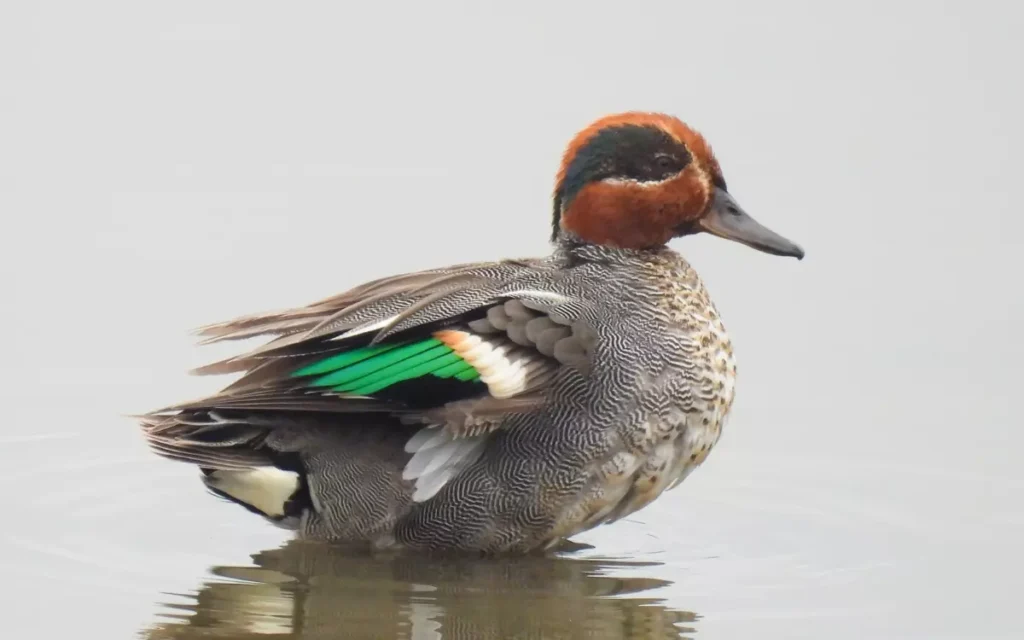
With their striking green wing patches, Green-winged Teals are unmistakable in flight. Their series of high-pitched whistles and nasal calls can be heard in Texas during both spring and fall migrations.
These dabbling ducks feed on aquatic plants and invertebrates. They lay 6-10 eggs. You can find them in various Texas wetlands during migration and winter.
- Length: 20.5 and 23 inches
- Weight: 1100 to 1400 grams
- Wingspan: 102 to 122.5 cm
Call:-
Male
Female
10. Black-bellied Whistling Duck (Dendrocygna autumnalis):

Known for their unique whistling calls that sound almost like human whistles, Black-bellied Whistling Ducks are a treat to observe.
Their distinctive black belly and grayish head contrast beautifully with their chestnut sides. These ducks are year-round residents in Texas.
These unique ducks feed on plants and insects. They nest in tree cavities, laying 8-18 eggs. They are often seen in Texas year-round, especially in marshes and ponds.
- Length: 19 – 22 in (48 – 56 cm).
- Weight: 21.16 – 28.22 oz (600 – 800 gm).
- Wingspan: 30 – 37 in (76 – 94 cm).
Call:-
Male
Female
11. Ruddy Duck (Oxyura jamaicensis):

Ruddy Ducks are known for their bright blue bills and tails. During their courtship displays, males inflate their necks to create a striking appearance.
Their calls are characterized by soft whistles and grunts, adding a touch of intrigue to their presence in Texas during the winter months.
Ruddy ducks dive for aquatic plants and invertebrates. They lay 6-10 eggs. Look for them in Texas during migration and winter in lakes and ponds.
- Length: 14 – 17 in(35 – 43 cm )
- Weight: 15.87 – 26.46 oz (450 – 750 gm)
- Wingspan: 21 – 25 in(53 – 64 cm )
Call:-
Male
Female
12. Redhead (Aythya americana):

The Redhead’s vibrant cinnamon head sets it apart from other diving ducks. Their calls range from soft quacks to wheezy whistles, creating an engaging soundscape in their preferred habitats during the winter.
Redheads dive for aquatic plants and invertebrates. They lay 8-14 eggs. These ducks can be found in Texas during winter in coastal and inland waters.
- Length: 18 – 22 in (46 – 56 cm)
- Weight: 43.03 oz (1219 g)
- Wingspan: 29 – 35 in (74 – 89 cm)
Call:-
Male
Female
13. Canvasback (Aythya valisineria):

The Canvasback’s long, sloping profile and distinct white body make it a memorable sight. Their calls are a mix of grunts and softer quacks. During winter, they can be found in lakes and coastal waters across Texas.
Canvasbacks dive for plant material and mollusks. They lay 6-10 eggs. Look for them during winter in Texas along lakes and coastal areas.
- Length: 19 – 24 in (48 – 61 cm)
- Weight: 58.48 oz (1657 g)
- Wingspan: 28 – 36 in (71 – 91 cm)
14. Lesser Scaup (Aythya affinis):

Identifiable by their grayish body and iridescent purple head, Lesser Scaups often gather in large flocks during migration.
Their calls are characterized by a mix of grunts and whistles, creating a dynamic auditory experience.
Lesser scaups dive for aquatic plants and invertebrates. They lay 8-12 eggs. Common winter visitors to Texas lakes, ponds, and coastal waters.
- Length: 15 – 18 in (38 – 49 cm)
- Weight: 40.77 oz (1155 g)
- Wingspan: 24 – 33 in (61 – 84 cm)
Call:-
Male
Female
15. Fulvous Whistling Duck (Dendrocygna bicolor):
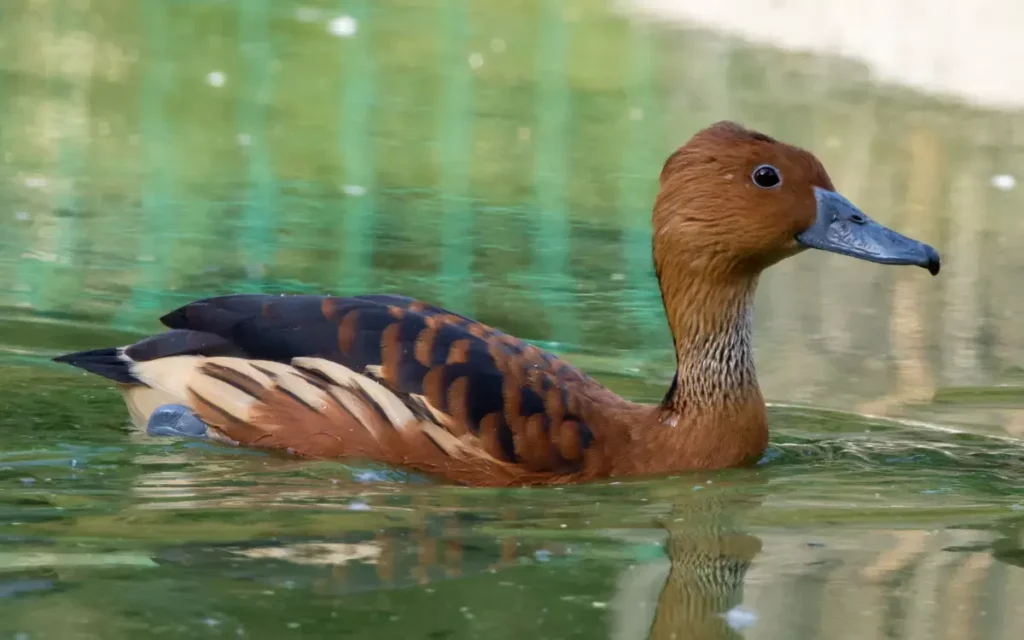
Fulvous Whistling Ducks are unique with their tawny plumage and long legs. Their distinctive whistling calls can be heard during their active periods at dawn and dusk. These ducks are a treat to observe as they forage in Texas wetlands.
Fulvous ducks feed on aquatic plants and insects. They nest in grassy areas, laying 8-12 eggs. Often seen in Texas marshes and wetlands.
- Length: 18 -21 in (45 – 53 cm)
- Weight: around 25.6 oz (726 gm)
- Wingspan: 36 in (91 cm)
16. Cinnamon Teal (Spatula cyanoptera):

Cinnamon Teals stand out with their vibrant reddish-brown plumage and stunning blue patches on their wings. Their calls are a series of soft, musical whistles that add to the serene ambiance of the wetlands.
Cinnamon teals feed on aquatic plants and invertebrates. They lay 6-15 eggs. Rare in Texas, they might appear in wetlands during migration.
- Length: 14- 17 in (36 – 43 cm)
- Weight: around16.4 oz (465 g)
- Wingspan: 24 – 30 in (61 -76 cm)
Call:-
Male
Female
17. Northern Shoveler (Spatula clypeata):

Easily recognizable due to their spatula-shaped bills, Northern Shovelers emit a series of distinctive “quack-qua-quack” calls. Their striking coloration and energetic feeding behaviors make them a fascinating sight.
Shovelers feed by filtering water through their uniquely shaped bills, consuming plants and invertebrates. They lay 9-11 eggs. Common winter visitors to Texas wetlands.
- Length: 17.3 – 20.1 in (44 – 51 cm)
- Weight: 14.1 – 28.9 oz (400 – 820 g)
- Wingspan: 27.2 – 33.1 in (69 – 84 cm)
Call:-
Male
Female
18. Ring-necked Duck (Aythya collaris):

The Ring-necked Duck, despite its name, doesn’t have a readily visible ring on its neck. These ducks emit a variety of sounds, including nasal calls and soft whistles, often heard during their winter migration in Texas.
Ring-necked ducks dive for aquatic plants and invertebrates. They lay 8-10 eggs. Found in Texas during migration and winter, especially in lakes and ponds.
- Length: 14 – 18 in (36 – 46 cm)
- Weight : 32.09 oz (909 g)
- Wingspan: 24 – 30 in (61 – 76 cm)
Call:-
Call:-
Male
Female
19. Hooded Merganser (Lophodytes cucullatus):

With their striking crests and elaborate courtship displays, Hooded Mergansers are a captivating sight. Their calls are a mix of croaks and soft, plaintive notes. These ducks frequent wooded ponds and rivers during the colder months.
Hooded mergansers dive for fish and aquatic invertebrates. They nest in tree cavities, laying 7-12 eggs. Look for them in Texas during migration and winter.
- Length: 15.8-19.3 in (40-49 cm)
- Weight: 16.0-31.0 oz (453-879 g)
- Wingspan: 23.6-26.0 in (60-66 cm)
Call:-
Male
Female
20. Common Merganser (Mergus merganser):

The Common Merganser, with its long body and serrated bill, is known for its distinctive fishing habits. Their harsh, croaking calls resonate as they navigate through Texas waters during their migration periods.
Common mergansers dive for fish and aquatic invertebrates. They lay 6-12 eggs. Rare winter visitors in Texas, mostly found on lakes and rivers.
- Length: 22 – 27 in (56 – 69 cm)
- Weight: 60.8 oz (1723 gm)
- Wingspan: 31 – 37 in (79 – 94 cm)
Call:-
Male
Female
Read also:-
21. Muscovy Duck (Cairina moschata):

The Muscovy Duck is a domesticated species often seen in parks and urban areas. Their hissing and grunting sounds are a common part of the city’s soundscape. Despite their large size, these ducks are relatively silent.
Muscovy ducks forage for plants and insects. They nest in tree cavities, laying 8-16 eggs. Often seen in Texas year-round, near urban and rural water sources.
- Length: 25 – 35 in (64 – 89 cm)
- Weight: 102.4 oz (2902 g)
- Wingspan: 54 – 60 in (137 – 152 cm)
22. Greater Scaup (Aythya marila):

Similar to the Lesser Scaup but larger, the Greater Scaup is known for its striking black and white appearance. Their vocalizations are a mix of low grunts and whistles, contributing to the auditory tapestry of winter water bodies.
Greater scaups dive for aquatic plants and invertebrates. They lay 9 eggs. Common winter visitors to Texas coastal waters and inland lakes.
- Length: 39–56 cm (15–22 in)
- Weight: 25.6-48.0 oz (726-1360 g)
- Wingspan: 71–84 cm (28–33 in)
23. Blue-winged Teal (Spatula discors):

Blue-winged Teals are easily identified by their blue wing patches and mottled bodies. Their whistling calls and series of musical notes add a touch of liveliness to wetlands during their migratory periods.
Blue-winged teals feed on plants and invertebrates. They lay 6-14 eggs. You can find them in Texas wetlands during migration and winter.
- Length: 14.2-16.1 in (36-41 cm)
- Weight: 8.1-19.2 oz (230-545 g)
- Wingspan: 22.1-24.4 in (56-62 cm)
Call:-
Male
Female
24. Common Goldeneye (Bucephala clangula):
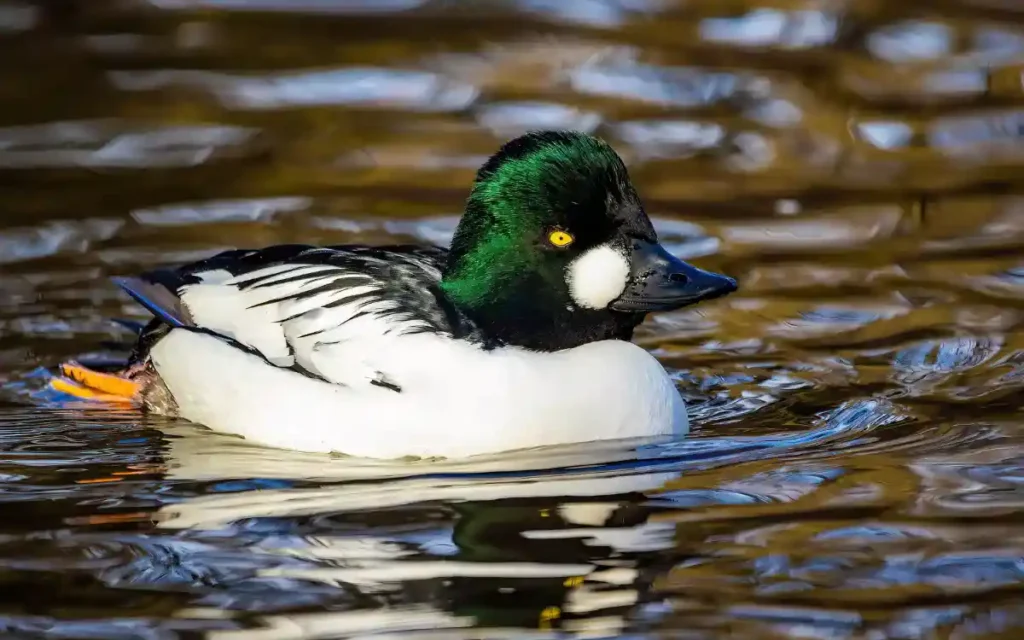
The Common Goldeneye’s striking black and white plumage makes it a remarkable sight on lakes and rivers. Their calls are a mix of whistles and croaks, complementing their active and agile diving behaviors.
Common goldeneyes dive for fish and aquatic invertebrates. They nest in tree cavities, laying 4-12 eggs. Uncommon in Texas, found in winter on lakes and coastal waters.
- Length: 15.8-20.1 in (40-51 cm)
- Weight: 21.2-45.9 oz (600-1300 g)
- Wingspan: 30.3-32.7 in (77-83 cm)
Call:-
Male
Female
25. Red-breasted Merganser (Mergus serrator):
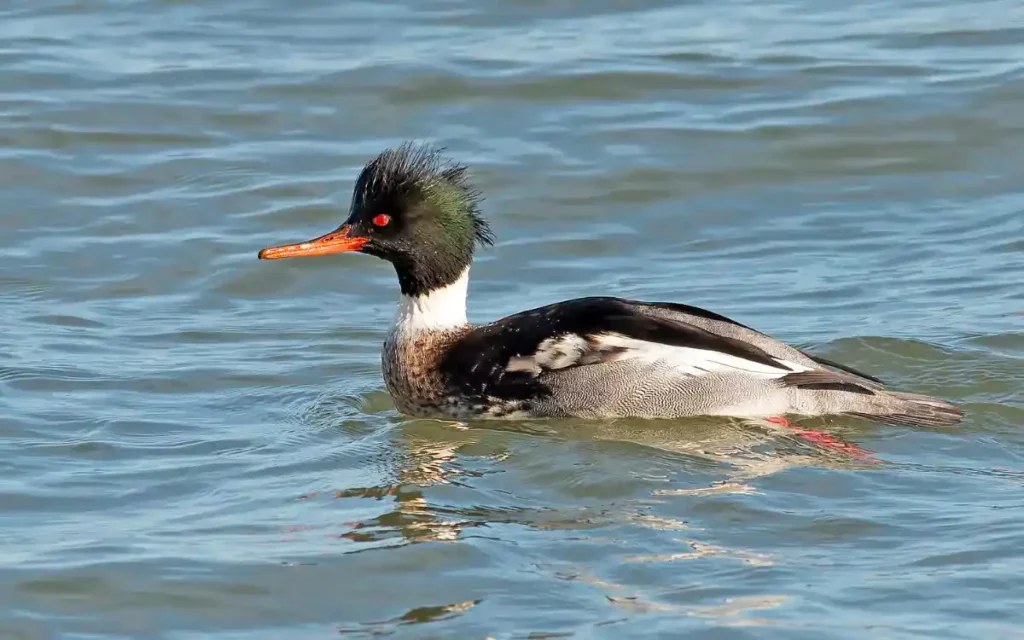
Distinguished by their reddish-brown necks and shaggy crests, Red-breasted Mergansers are skilled divers and fishers. Their hoarse croaks and soft whistles can be heard during their winter stays in Texas.
Red-breasted mergansers dive for fish and invertebrates. They nest near water, laying 3-24 eggs. Rare winter visitors in Texas, mainly along the coast.
- Length: 20.1-25.2 in (51-64 cm)
- Weight: 28.2-47.6 oz (800-1350 g)
- Wingspan: 26.0-29.1 in (66-74 cm)
Call:-
Male
Female
26. Mexican Duck (Anas diazi):

The Mexican Duck, often confused with Mallards, has a slightly darker and more uniform appearance. These ducks emit a variety of quacks and soft calls, contributing to the symphony of Texas wetlands.
Mexican ducks forage for plants and insects. They nest in grassy areas near water, laying 4-9 eggs. Common year-round in Texas wetlands and ponds.
- Length: 17.7 – 22 in (45 – 56 cm )
- Weight: 24 – 52.8 oz (700 – 1,500 grams)
- Wingspan: 32 – 37 in (81 – 95 cm)
27. Snow Goose (Anser caerulescens):

The Snow Goose, known for its white plumage, often forms large, spectacular flocks during migration. Their calls are a mix of cackles, honks, and barks, creating an awe-inspiring auditory experience.
Snow geese feed on plants in fields and marshes. They nest in Arctic regions, laying 2-5 eggs. Rare winter visitors in Texas, often in coastal and wetland areas.
- Length: 27.2-32.7 in (69-83 cm)
- Weight:56.4-116.4 oz (1600-3300 g)
- Wingspan: 54.3 in (138 cm)
28. Canada Goose (Branta canadensis):

The Canada Goose is a familiar sight in parks, golf courses, and lakes across Texas. Their honks and occasional hisses contribute to the unmistakable soundscape of urban and natural areas.
Canada geese graze on grasses and aquatic plants. They nest in various habitats, laying 5 eggs. Common winter visitors in Texas, especially around ponds and lakes.
- Length: 29.9-43.3 in (76-110 cm)
- Weight: 105.8-317.5 oz (3000-9000 g)
- Wingspan: 50.0-66.9 in (127-170 cm)
29. White-winged Scoter (Melanitta fusca):

White-winged Scoters, with their dark bodies and distinctive white patches on their wings, prefer coastal waters during their winter migration. Their calls are a series of low, melodious whistles.
White-winged scoters dive for mollusks and crustaceans. They nest in tree cavities, laying 6-16 eggs. Rare in Texas, mostly found along the coast during winter.
- Length: 18.9-22.8 in (48-58 cm)
- Weight: 33.5-63.5 oz (950-1800 g)
- Wingspan: 31.5 in (80 cm)
30. Pied-billed Grebe (Podilymbus podiceps):

Although not a duck, the Pied-billed Grebe is a common waterbird in Texas. Their distinctive calls, resembling a chuckling laugh, echo across marshes and ponds.
Pied-billed grebes dive for fish and aquatic invertebrates. They nest in floating vegetation, laying 4-10 eggs. Common year-round in Texas wetlands.
- Length: 11.8-15.0 in (30-38 cm)
- Weight: 8.9-20.0 oz (253-568 g)
- Wingspan: 17.7-24.4 in (45-62 cm)
31. Black Scoter (Melanitta americana):

Black Scoters are known for their all-black plumage and bright yellow knobs on their bills. Their calls are a mix of nasal notes and grunts, contributing to the diversity of coastal bird sounds.
Black scoters dive for mollusks and crustaceans. They nest in ground depressions, laying 5-9 eggs. Rare in Texas, mainly along the coast during winter.
- Length: 16.9-19.3 in (43-49 cm)
- Weight: 30.4-38.8 oz (862-1100 g)
- Wingspan: 27.6-28.4 in (70-72 cm)
32. Masked Duck (Nomonyx dominicus):
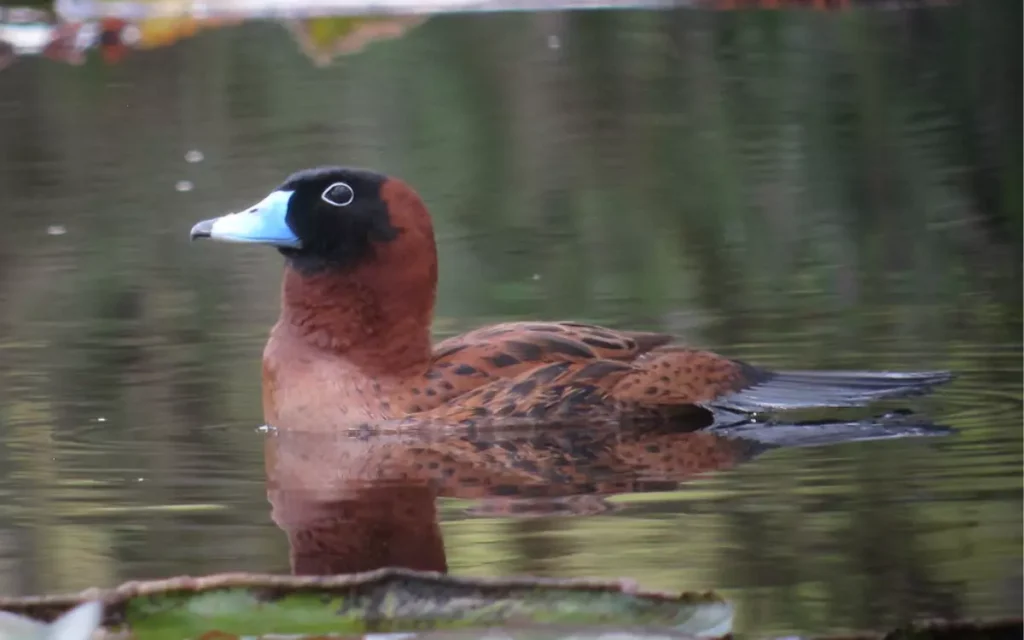
Masked Ducks are rare and elusive, often found in densely vegetated marshes. Despite their secretive nature, their distinctive barking and grunting calls reveal their presence.
Masked ducks forage for plants and invertebrates. They nest in dense vegetation near water, laying 7-10 eggs. Uncommon in Texas, found in wetlands and marshes.
- Length: 13 in (33 cm)
- Weight: 12.8 oz (363 g)
- Wingspan: 17 in (43 cm)
33. Common Loon (Gavia immer):

Common Loons, although primarily found on lakes, can sometimes be seen in Texas during migration. Their eerie, haunting calls are an iconic sound of northern lakes and waters.
Common loons dive for fish. They nest near water, laying 2 eggs. Rare winter visitors in Texas, often on large lakes and coastal waters.
- Length: 26.0-35.8 in (66-91 cm)
- Weight: 88.2-215.2 oz (2500-6100 g)
- Wingspan: 40.9-51.6 in (104-131 cm)
34. Double-crested Cormorant (Phalacrocorax auritus):

While not a duck, the Double-crested Cormorant is a common waterbird in Texas. Their guttural croaks and grunting noises punctuate the shores of lakes and rivers.
Cormorants dive for fish. They nest in colonies, laying 2-7 eggs. Common year-round in Texas, especially near lakes, rivers, and coastal areas.
- Length: 27.6-35.4 in (70-90 cm)
- Weight: 42.3-88.2 oz (1200-2500 g)
- Wingspan: 44.9-48.4 in (114-123 cm)
35. American Coot (Fulica americana)

American Coots are often mistaken for ducks due to their similar appearance. Their calls range from a variety of clucks to cackles, creating a lively atmosphere in their wetland habitats.
American coots feed on aquatic plants and invertebrates. They build floating nests, laying 6-12 eggs. Common year-round in Texas wetlands and ponds.
- Length: 15.5-16.9 in (39.4-42.9 cm)
- Weight: 21.2-24.7 oz (600-700 g)
- Wingspan: 23.0-25.0 in (58.4-63.5 cm)
36. Greater White-fronted Goose (Anser albifrons):

The Greater White-fronted Goose, with its distinctive white face and brown body, emits a mix of high-pitched yodeling calls and excited honks. These geese are often seen in agricultural fields during migration.
White-fronted geese graze on grasses and grains. They nest in Arctic regions, laying 4-7 eggs. Winter visitors in Texas, often in agricultural fields.
- Length: 25.2-31.9 in (64-81 cm)
- Weight: 68.8-116.8 oz (1951-3311 g)
- Wingspan: 53.1 in (135 cm)
37. Western Grebe (Aechmophorus occidentalis):

The Western Grebe, although not a duck, is a fascinating waterbird with a distinctive long neck and striking black-and-white plumage. Their eerie, haunting calls are a hallmark of lakes and reservoirs.
Western grebes dive for fish. They nest in colonies on the water, laying 2 eggs. Rare winter visitors in Texas, mainly on large lakes and coastal waters.
- Length: 21.6-29.5 in (55-75 cm)
- Weight: 40.1-64.4 oz (1138-1826 g)
- Wingspan: 22.8-25.2 in (58-64 cm)
38. Ross’s Goose (Anser rossii):

Ross’s Geese, smaller and with rounder heads than Snow Geese, emit high-pitched honks that distinguish them from their larger relatives. These geese often gather in large flocks during migration.
Ross’s geese graze on grasses and grains. They nest in Arctic regions, laying 4 eggs. Rare winter visitors in Texas, often mixed with snow geese.
- Length: 23.2-25.2 in (59-64 cm)
- Weight: 42.3-55.3 oz (1198-1567 g)
- Wingspan: 44.5-45.7 in (113-116 cm)
39. Black-necked Grebe (Podiceps nigricollis):
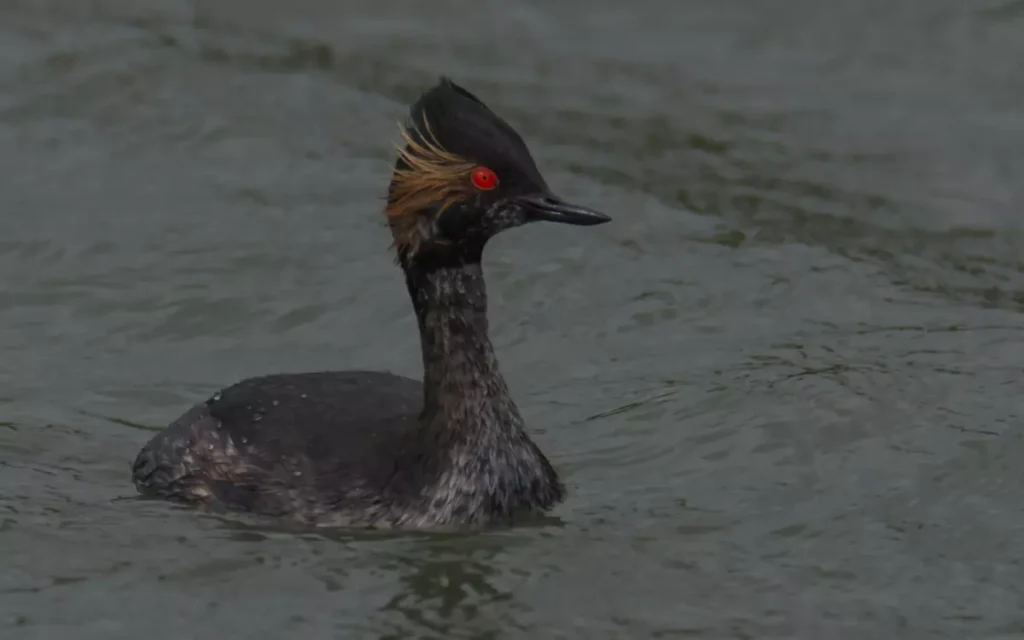
The Black-necked Grebe, with its dark neck and distinctive yellow patch behind the eye, emits a variety of whinnying calls during the breeding season. These grebes are often seen on open waters.
Black-necked grebes dive for fish. They nest in floating vegetation, laying 3-4 eggs. Uncommon in Texas, found in wetlands during migration.
- Length: 16.9-22.1 in (43-56 cm)
- Weight: 28.2-56.4 oz (800-1600 g)
- Wingspan: 24.0-34.6 in (61-88 cm)
40. American White Pelican (Pelecanus erythrorrhynchos):

The American White Pelican is an impressive sight, with its massive size and distinctive long bill. Their low, guttural grunts and growls contrast their majestic appearance.
White pelicans feed on fish. They nest in colonies, laying 2-4 eggs. Common winter visitors in Texas, especially in lakes and coastal areas.
- Length: 50.0-65.0 in (127-165 cm)
- Weight: 158.7-317.5 oz (4500-9000 g)
- Wingspan: 96.1-114.2 in (244-290 cm)
41. Brown Pelican (Pelecanus occidentalis):

The Brown Pelican, often associated with coastal areas, emits a mix of grunts and hoarse sounds. Their graceful flights and dramatic dives create an unforgettable spectacle along Texas shorelines.
Brown pelicans dive for fish. They nest in colonies, laying 3 eggs. Common year-round in Texas along the coast.
- Length: 39.4-53.9 in (100-137 cm)
- Weight: 70.5-176.4 oz (2000-5000 g)
- Wingspan: 78.7 in (200 cm)
Some FAQs about this ducks :
Q: What kinds of ducks are in Texas?
Ans: Texas is home to a variety of ducks including Mallards, Northern Pintails, Wood Ducks, Teal (Blue-winged and Green-winged), and Mexican Ducks.
Q: What is the rarest duck in Texas?
Ans: The Black-bellied Whistling Duck is considered relatively rare in Texas, primarily found in the southeastern parts of the state.
Q: What ducks migrate through Texas?
Ans: Many species migrate through Texas, such as the Canvasback, Redhead, and various species of Teal and Diving Ducks.
Q: What eats ducks in Texas?
Ans: Ducks in Texas are preyed upon by alligators, foxes, coyotes, large birds of prey (like eagles and hawks), and raccoons.
Q: What bird looks like a duck in Texas?
Ans: The American Coot, often found in similar habitats, resembles a duck but has a distinctive white beak and slate-gray body.
Q: What ducks live in trees in Texas?
Ans: The Wood Duck is known for nesting in tree cavities and is commonly found in Texas, particularly in wooded swamps and marshes.
Conclusion:
Texas has 41 different species of ducks, showing a rich diversity. Learning about these ducks highlights the need to protect their environment, ensuring they thrive for years to come.






